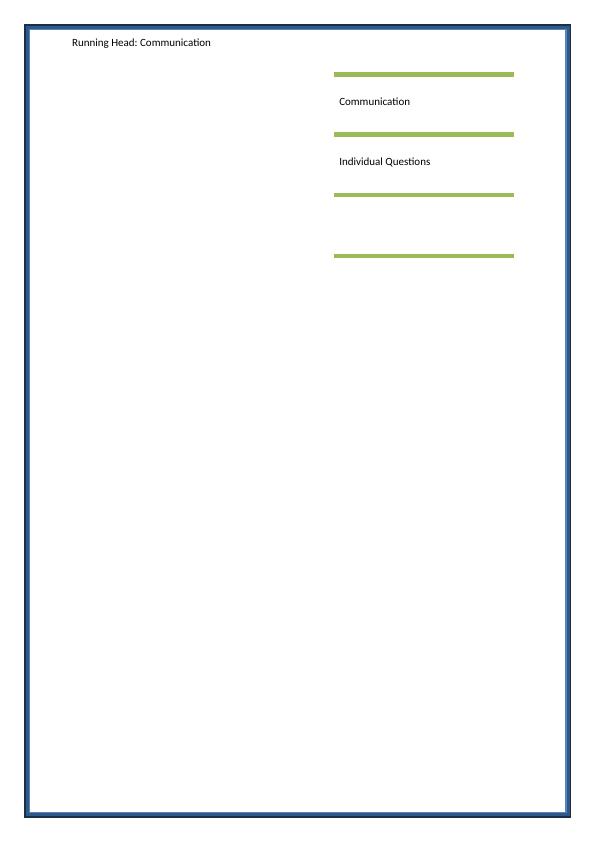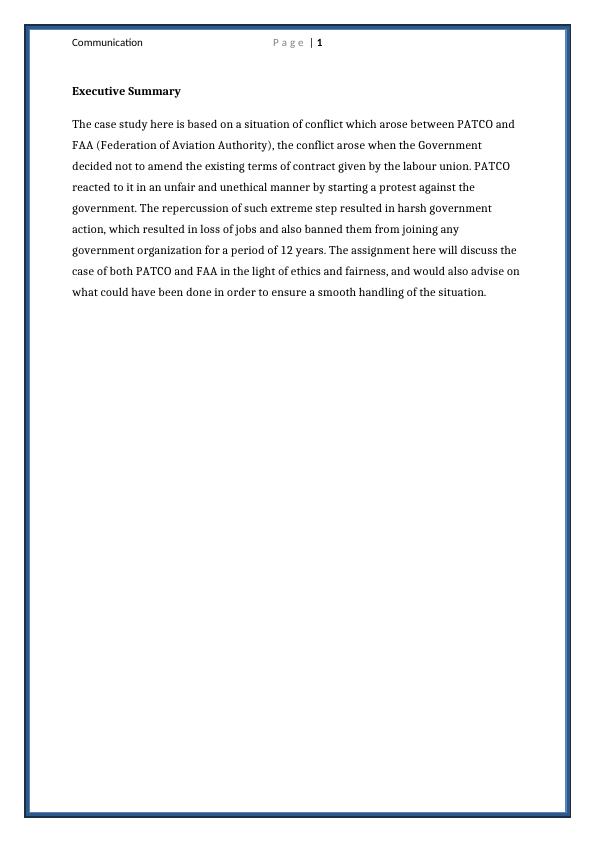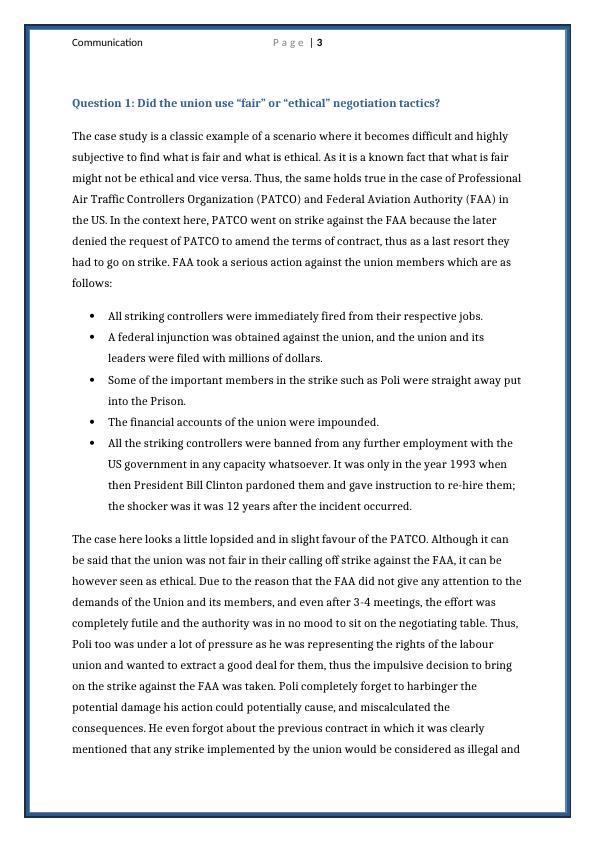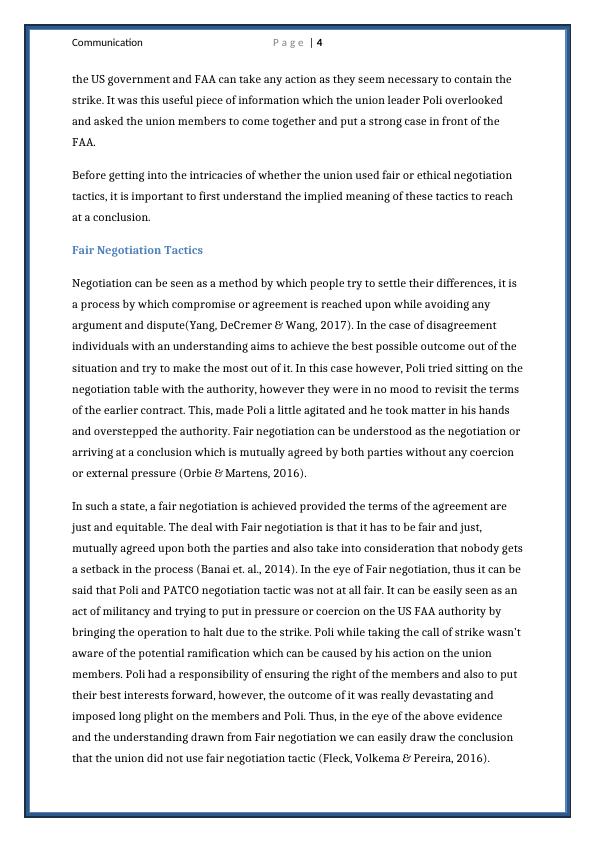Negotiation Tactics and Government Response in PATCO-FAA Conflict
Added on 2023-06-10
25 Pages8593 Words433 Views
Running Head: Communication
Communication
Individual Questions
Communication
Individual Questions

Communication P a g e | 1
Executive Summary
The case study here is based on a situation of conflict which arose between PATCO and
FAA (Federation of Aviation Authority), the conflict arose when the Government
decided not to amend the existing terms of contract given by the labour union. PATCO
reacted to it in an unfair and unethical manner by starting a protest against the
government. The repercussion of such extreme step resulted in harsh government
action, which resulted in loss of jobs and also banned them from joining any
government organization for a period of 12 years. The assignment here will discuss the
case of both PATCO and FAA in the light of ethics and fairness, and would also advise on
what could have been done in order to ensure a smooth handling of the situation.
Executive Summary
The case study here is based on a situation of conflict which arose between PATCO and
FAA (Federation of Aviation Authority), the conflict arose when the Government
decided not to amend the existing terms of contract given by the labour union. PATCO
reacted to it in an unfair and unethical manner by starting a protest against the
government. The repercussion of such extreme step resulted in harsh government
action, which resulted in loss of jobs and also banned them from joining any
government organization for a period of 12 years. The assignment here will discuss the
case of both PATCO and FAA in the light of ethics and fairness, and would also advise on
what could have been done in order to ensure a smooth handling of the situation.

Communication P a g e | 2
Table of Content
Question 1: Did the union use “fair” or “ethical” negotiation tactics?..........................................................3
Fair Negotiation Tactics...............................................................................................................................................4
Ethical Negotiation........................................................................................................................................................ 5
Question 2: Was the government’s response to the strike fair and appropriate? Explain.................6
Rationale for the Fair and Appropriate action by the Government.........................................................8
Question 3: Who was at fault in the negotiation breakdown and why?...................................................10
Question 4: What do you think could have been done better by PATCO? By the Government?...13
Things to be done differently by PATCO................................................................................................................14
Conflict resolution Strategies.................................................................................................................................14
Accommodating.......................................................................................................................................................14
Avoiding...................................................................................................................................................................... 15
Collaborating............................................................................................................................................................ 15
Compromising..........................................................................................................................................................15
Competing.................................................................................................................................................................. 16
Bargaining Strategies.................................................................................................................................................16
Distributive Negotiation......................................................................................................................................17
Integrative Negotiation.............................................................................................................................................17
Integrative V/s Distributive Negotiation..........................................................................................................17
Things could have been done better by the Government...............................................................................18
Openness in Communication..................................................................................................................................18
Conflict Resolution...................................................................................................................................................... 19
References........................................................................................................................................................................... 20
Table of Content
Question 1: Did the union use “fair” or “ethical” negotiation tactics?..........................................................3
Fair Negotiation Tactics...............................................................................................................................................4
Ethical Negotiation........................................................................................................................................................ 5
Question 2: Was the government’s response to the strike fair and appropriate? Explain.................6
Rationale for the Fair and Appropriate action by the Government.........................................................8
Question 3: Who was at fault in the negotiation breakdown and why?...................................................10
Question 4: What do you think could have been done better by PATCO? By the Government?...13
Things to be done differently by PATCO................................................................................................................14
Conflict resolution Strategies.................................................................................................................................14
Accommodating.......................................................................................................................................................14
Avoiding...................................................................................................................................................................... 15
Collaborating............................................................................................................................................................ 15
Compromising..........................................................................................................................................................15
Competing.................................................................................................................................................................. 16
Bargaining Strategies.................................................................................................................................................16
Distributive Negotiation......................................................................................................................................17
Integrative Negotiation.............................................................................................................................................17
Integrative V/s Distributive Negotiation..........................................................................................................17
Things could have been done better by the Government...............................................................................18
Openness in Communication..................................................................................................................................18
Conflict Resolution...................................................................................................................................................... 19
References........................................................................................................................................................................... 20

Communication P a g e | 3
Question 1: Did the union use “fair” or “ethical” negotiation tactics?
The case study is a classic example of a scenario where it becomes difficult and highly
subjective to find what is fair and what is ethical. As it is a known fact that what is fair
might not be ethical and vice versa. Thus, the same holds true in the case of Professional
Air Traffic Controllers Organization (PATCO) and Federal Aviation Authority (FAA) in
the US. In the context here, PATCO went on strike against the FAA because the later
denied the request of PATCO to amend the terms of contract, thus as a last resort they
had to go on strike. FAA took a serious action against the union members which are as
follows:
All striking controllers were immediately fired from their respective jobs.
A federal injunction was obtained against the union, and the union and its
leaders were filed with millions of dollars.
Some of the important members in the strike such as Poli were straight away put
into the Prison.
The financial accounts of the union were impounded.
All the striking controllers were banned from any further employment with the
US government in any capacity whatsoever. It was only in the year 1993 when
then President Bill Clinton pardoned them and gave instruction to re-hire them;
the shocker was it was 12 years after the incident occurred.
The case here looks a little lopsided and in slight favour of the PATCO. Although it can
be said that the union was not fair in their calling off strike against the FAA, it can be
however seen as ethical. Due to the reason that the FAA did not give any attention to the
demands of the Union and its members, and even after 3-4 meetings, the effort was
completely futile and the authority was in no mood to sit on the negotiating table. Thus,
Poli too was under a lot of pressure as he was representing the rights of the labour
union and wanted to extract a good deal for them, thus the impulsive decision to bring
on the strike against the FAA was taken. Poli completely forget to harbinger the
potential damage his action could potentially cause, and miscalculated the
consequences. He even forgot about the previous contract in which it was clearly
mentioned that any strike implemented by the union would be considered as illegal and
Question 1: Did the union use “fair” or “ethical” negotiation tactics?
The case study is a classic example of a scenario where it becomes difficult and highly
subjective to find what is fair and what is ethical. As it is a known fact that what is fair
might not be ethical and vice versa. Thus, the same holds true in the case of Professional
Air Traffic Controllers Organization (PATCO) and Federal Aviation Authority (FAA) in
the US. In the context here, PATCO went on strike against the FAA because the later
denied the request of PATCO to amend the terms of contract, thus as a last resort they
had to go on strike. FAA took a serious action against the union members which are as
follows:
All striking controllers were immediately fired from their respective jobs.
A federal injunction was obtained against the union, and the union and its
leaders were filed with millions of dollars.
Some of the important members in the strike such as Poli were straight away put
into the Prison.
The financial accounts of the union were impounded.
All the striking controllers were banned from any further employment with the
US government in any capacity whatsoever. It was only in the year 1993 when
then President Bill Clinton pardoned them and gave instruction to re-hire them;
the shocker was it was 12 years after the incident occurred.
The case here looks a little lopsided and in slight favour of the PATCO. Although it can
be said that the union was not fair in their calling off strike against the FAA, it can be
however seen as ethical. Due to the reason that the FAA did not give any attention to the
demands of the Union and its members, and even after 3-4 meetings, the effort was
completely futile and the authority was in no mood to sit on the negotiating table. Thus,
Poli too was under a lot of pressure as he was representing the rights of the labour
union and wanted to extract a good deal for them, thus the impulsive decision to bring
on the strike against the FAA was taken. Poli completely forget to harbinger the
potential damage his action could potentially cause, and miscalculated the
consequences. He even forgot about the previous contract in which it was clearly
mentioned that any strike implemented by the union would be considered as illegal and

Communication P a g e | 4
the US government and FAA can take any action as they seem necessary to contain the
strike. It was this useful piece of information which the union leader Poli overlooked
and asked the union members to come together and put a strong case in front of the
FAA.
Before getting into the intricacies of whether the union used fair or ethical negotiation
tactics, it is important to first understand the implied meaning of these tactics to reach
at a conclusion.
Fair Negotiation Tactics
Negotiation can be seen as a method by which people try to settle their differences, it is
a process by which compromise or agreement is reached upon while avoiding any
argument and dispute(Yang, DeCremer & Wang, 2017). In the case of disagreement
individuals with an understanding aims to achieve the best possible outcome out of the
situation and try to make the most out of it. In this case however, Poli tried sitting on the
negotiation table with the authority, however they were in no mood to revisit the terms
of the earlier contract. This, made Poli a little agitated and he took matter in his hands
and overstepped the authority. Fair negotiation can be understood as the negotiation or
arriving at a conclusion which is mutually agreed by both parties without any coercion
or external pressure (Orbie & Martens, 2016).
In such a state, a fair negotiation is achieved provided the terms of the agreement are
just and equitable. The deal with Fair negotiation is that it has to be fair and just,
mutually agreed upon both the parties and also take into consideration that nobody gets
a setback in the process (Banai et. al., 2014). In the eye of Fair negotiation, thus it can be
said that Poli and PATCO negotiation tactic was not at all fair. It can be easily seen as an
act of militancy and trying to put in pressure or coercion on the US FAA authority by
bringing the operation to halt due to the strike. Poli while taking the call of strike wasn’t
aware of the potential ramification which can be caused by his action on the union
members. Poli had a responsibility of ensuring the right of the members and also to put
their best interests forward, however, the outcome of it was really devastating and
imposed long plight on the members and Poli. Thus, in the eye of the above evidence
and the understanding drawn from Fair negotiation we can easily draw the conclusion
that the union did not use fair negotiation tactic (Fleck, Volkema & Pereira, 2016).
the US government and FAA can take any action as they seem necessary to contain the
strike. It was this useful piece of information which the union leader Poli overlooked
and asked the union members to come together and put a strong case in front of the
FAA.
Before getting into the intricacies of whether the union used fair or ethical negotiation
tactics, it is important to first understand the implied meaning of these tactics to reach
at a conclusion.
Fair Negotiation Tactics
Negotiation can be seen as a method by which people try to settle their differences, it is
a process by which compromise or agreement is reached upon while avoiding any
argument and dispute(Yang, DeCremer & Wang, 2017). In the case of disagreement
individuals with an understanding aims to achieve the best possible outcome out of the
situation and try to make the most out of it. In this case however, Poli tried sitting on the
negotiation table with the authority, however they were in no mood to revisit the terms
of the earlier contract. This, made Poli a little agitated and he took matter in his hands
and overstepped the authority. Fair negotiation can be understood as the negotiation or
arriving at a conclusion which is mutually agreed by both parties without any coercion
or external pressure (Orbie & Martens, 2016).
In such a state, a fair negotiation is achieved provided the terms of the agreement are
just and equitable. The deal with Fair negotiation is that it has to be fair and just,
mutually agreed upon both the parties and also take into consideration that nobody gets
a setback in the process (Banai et. al., 2014). In the eye of Fair negotiation, thus it can be
said that Poli and PATCO negotiation tactic was not at all fair. It can be easily seen as an
act of militancy and trying to put in pressure or coercion on the US FAA authority by
bringing the operation to halt due to the strike. Poli while taking the call of strike wasn’t
aware of the potential ramification which can be caused by his action on the union
members. Poli had a responsibility of ensuring the right of the members and also to put
their best interests forward, however, the outcome of it was really devastating and
imposed long plight on the members and Poli. Thus, in the eye of the above evidence
and the understanding drawn from Fair negotiation we can easily draw the conclusion
that the union did not use fair negotiation tactic (Fleck, Volkema & Pereira, 2016).

Communication P a g e | 5
The same can also be seen by analysing the position of the FAA; the authority suffered a
major blow due to the strike. The employees by not coming to the work could have led
to potential and fatal accidents. Hence, it was highly unfair on the grounds of union
members and Poli who went selfish and completely forego the needs and the modalities
of their action (McDermott, 2016). At the very same time, Poli did not care about the
ramification for the family members of the union members, the lives of the people
would have been impacted due to the consequence of the strike. Thus in light of all the
stakeholders who were or would have been impacted by this strike, it can be easily
concluded that it was highly unfair (Gasper & Chen, 2016).
Ethical Negotiation
In the simplest way, the definition of ethics can be understood as a system of moral
principles or values, it is the rules or standards governing the conduct of the members
of a profession with accepted principles of right and wrong(Zohar, 2015). Many
negotiators have described ethical negotiation as “ethical climate” because ethics are
reflected in different context where expectations are that negotiators are seeking to
maximize their own gains and are using the other parties as means not end in
themselves to achieve their own goals. Hence it can be said that ethical climate is a
function of more than just the behaviour alone, and it depends on the relationship
between the negotiator and the other party (Butler, 2016).
Ethics is something which is different for every person, as it is guided by the principles,
values, beliefs and moral of an individual and is partially influenced by the society in
which the individual is raised, thus what is ethical for one might not be ethical for the
other person. Thus, ethical negotiation can vary according to the situation and
individual. In the case of PATCO and FAA, PATCO was highly unfair as thy failed to bring
just, equality and fairness in their action; the actions were solely guided by the interest
of the union without any due consideration for any kind of consequences (Kowalczyk &
Kleka, 2015).
However, PATCO tried everything at their end to bring the negotiation to a win-win
table, but due to getting ignored by the FAA authority repeatedly they had to take
matter in their hand and take some action, which I their head was highly ethical. Poli
tried to negotiate with FAA as the union was not happy with the earlier terms of
The same can also be seen by analysing the position of the FAA; the authority suffered a
major blow due to the strike. The employees by not coming to the work could have led
to potential and fatal accidents. Hence, it was highly unfair on the grounds of union
members and Poli who went selfish and completely forego the needs and the modalities
of their action (McDermott, 2016). At the very same time, Poli did not care about the
ramification for the family members of the union members, the lives of the people
would have been impacted due to the consequence of the strike. Thus in light of all the
stakeholders who were or would have been impacted by this strike, it can be easily
concluded that it was highly unfair (Gasper & Chen, 2016).
Ethical Negotiation
In the simplest way, the definition of ethics can be understood as a system of moral
principles or values, it is the rules or standards governing the conduct of the members
of a profession with accepted principles of right and wrong(Zohar, 2015). Many
negotiators have described ethical negotiation as “ethical climate” because ethics are
reflected in different context where expectations are that negotiators are seeking to
maximize their own gains and are using the other parties as means not end in
themselves to achieve their own goals. Hence it can be said that ethical climate is a
function of more than just the behaviour alone, and it depends on the relationship
between the negotiator and the other party (Butler, 2016).
Ethics is something which is different for every person, as it is guided by the principles,
values, beliefs and moral of an individual and is partially influenced by the society in
which the individual is raised, thus what is ethical for one might not be ethical for the
other person. Thus, ethical negotiation can vary according to the situation and
individual. In the case of PATCO and FAA, PATCO was highly unfair as thy failed to bring
just, equality and fairness in their action; the actions were solely guided by the interest
of the union without any due consideration for any kind of consequences (Kowalczyk &
Kleka, 2015).
However, PATCO tried everything at their end to bring the negotiation to a win-win
table, but due to getting ignored by the FAA authority repeatedly they had to take
matter in their hand and take some action, which I their head was highly ethical. Poli
tried to negotiate with FAA as the union was not happy with the earlier terms of

End of preview
Want to access all the pages? Upload your documents or become a member.
Related Documents
The 1981 Air Traffic Controllers Strikelg...
|8
|1843
|97
Communication and Negotiation Skillslg...
|15
|3984
|166
Communication and Negotiation: Case Studies and Solutionslg...
|7
|1424
|81
Labour Law Assignment Reportlg...
|5
|1181
|15
Communication and Negotiation in Organizational Successlg...
|17
|6145
|60
Hunter Harrison Case Studylg...
|4
|571
|477